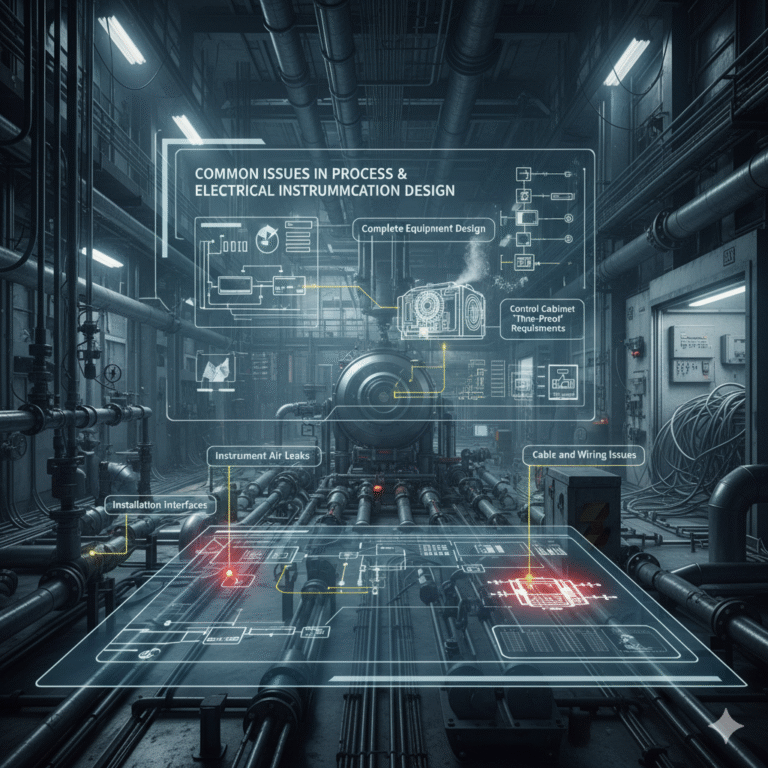In engineering projects, the intersection of process and electrical instrumentation design often becomes a hotspot for issues. From installation interfaces to instrument gas leaks, from design defects in complete sets of equipment to the “three-proof” requirements for control cabinets, these seemingly minor details can lead to significant risks during construction. Why do these problems keep recurring? How can we mitigate these risks in the design phase? This article explores common issues in process and electrical instrumentation design during engineering construction and discusses potential solutions.

Key Common Issues in Design
Installation Interfaces:
Often overlooked, installation interfaces between process and electrical instrumentation are a frequent source of issues. It is essential that these are clearly indicated in the drawings (especially axial diagrams), including instrument air sources, installation interfaces, and temperature probe insertion depths. Failure to display these can lead to significant construction challenges later.Instrument Air Leaks:
A common problem arises from poorly designed instrument air supply connections, which can cause air leakage and affect the normal functioning of valves and other instruments. These details must be clearly shown in the axial diagrams to prevent operational issues during installation.Complete Equipment Design:
Equipment design issues, such as improper angle settings for salt-nitrate centrifuge conveyors or failure to include a forward/reverse switching mechanism for the centrifuge unloading winch, can lead to increased maintenance costs. For example, if centrifuge wash water flows directly to the disc dryer, it can complicate maintenance.Level Instruments and Pump Wash Water:
In designs involving membrane-type level meters for sodium chloride and sodium sulfate systems, the wash water position is often inadequately positioned. To prevent inaccurate level readings, wash water should be added near the membrane, which should be clearly indicated in the design diagrams.Electrical and Instrumentation Integration:
In the design of complete equipment, the integration of electrical components with the main process equipment should be carefully considered. This includes the quantity and control method for pneumatic valves, the use of solenoid valves (single or double-acting), and ensuring the voltage and power supply requirements align with the process equipment.Control Cabinets and Protection Requirements:
Control cabinets for outdoor applications need to account for insulation during winter, anti-corrosion measures for electrical components, and sufficient cooling for variable frequency drives (VFDs). Specific environmental conditions, such as acidic or alkaline environments, must be thoroughly reviewed and factored into the design of control cabinets.Valve Selection and Procurement:
Pneumatic valve selection must take into account the specific operating conditions of the project. For example, in slurry systems, valves must be chosen carefully to prevent issues like sticking, which can significantly affect process control.DCS/PLC Stations:
The design of distributed control systems (DCS) or PLC stations often overlooks maintenance and accessibility requirements. Projects should consider the installation of additional control stations or expansion capabilities to avoid operational disruptions during future upgrades.Safety Facilities:
Safety facilities, such as dual-valve systems for hydrochloric acid and caustic soda tanks, must be carefully designed and shown clearly in the project plans to ensure safety during operation.Cable and Wiring Issues:
Cable entry points into distribution rooms and DCS cabinets need to be accurately planned, considering the size of cable trays and the number of pre-installed holes. Insufficient planning can lead to cable congestion, causing delays in the installation process.Material Procurement Standards:
For instrumentation procurement, standardization is critical. This includes ensuring that all electrical connections meet the requirements for flexible conduits, waterproof and corrosion-resistant connectors, and stainless steel tags for identification.Conclusion:
In actual construction, have you encountered similar issues? What are your experiences and solutions? We encourage you to share your thoughts in the comments section and engage in a collaborative exchange of ideas.
